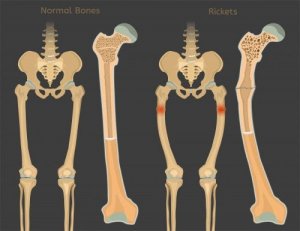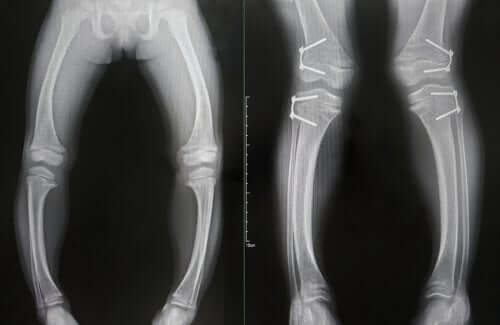Rickets: Vitamin D Deficiency in Children

Rickets is a disease that’s primarily caused by a vitamin D deficiency in children. This disease is very common in underdeveloped countries or developing countries.
It’s characterized by growth retardation and bone deformities. This condition is most common in children between six months and three years of age, as this is the fastest stage of growth.
What’s rickets?
Rickets is a disorder of the mineralization of bone and cartilage that’s still growing. Therefore, this disease only occurs in children. In the case of an alteration of mature bones, we’re talking about a different disorder, such as osteomalacia.
The process of bone mineralization depends on a balance between calcium and phosphorus, and this homeostasis is regulated by vitamin D. 99% of body calcium is found in the bones. When calcium levels decrease, parathyroid hormone levels increase. In turn, this causes a decrease in phosphorus levels.

Symptoms
As you’ll see below, rickets can be caused by a decrease in the levels of these minerals, as well as a decrease in vitamin D.
These are the main symptoms of this disorder:
- Stunted growth.
- Deformations in the bones, which soften. This condition is likely to cause bowed legs in the sufferers. It can also cause wear on the ends of some bones.
Other symptoms, such as seizures due to extremely low blood calcium levels, may manifest. Sometimes, teeth alterations, teeth, muscle cramps, and weakness also manifest.
Causes of rickets
As we mentioned above, the most common cause of this condition is vitamin D deficiency. However, other factors can also trigger the onset of this disorder. Genetic and metabolic causes are among them.
Vitamin D deficiency
Vitamin D is a fat-soluble vitamin that’s essential for calcium absorption. When you have a vitamin D deficiency, your body can’t absorb the intestinal calcium that comes from food. The same goes for phosphorus.
Thus, the blood levels of these minerals decrease and the body tries to restore them by extracting them from bones. Therefore, the bones become soft and easily deformed.
Since this disease became known and widely studied, rickets cases caused by vitamin D deficiency have decreased a lot, at the least in developed countries. This is thanks to prevention campaigns and the systematic administration of said vitamin to all children.
However, you can also get vitamin D through your diet, especially by consuming certain fish. In this regard, the human body can even synthesize it on the skin thanks to solar radiation.

Diagnosis and treatment of rickets
The diagnosis of this condition is based on the combination of altered analytical and radiographic findings and the presence of the typical clinical symptoms we explained above.
Blood tests can detect low levels of phosphorus and calcium, as well as of the alkaline phosphatase enzyme or vitamin D.
In general, the treatment consists of administering calciferol orally. However, this isn’t effective in some cases of rickets, such as those generally caused by low phosphorus levels due to its removal through the kidneys.
As a preventive measure, approximately 400 IU of vitamin D is currently administered daily to all children from birth to age two. You can also get vitamin D through sun exposure.
Conclusion
Rickets is a bone disorder mainly caused by a vitamin D deficiency in children. This condition can be prevented with an adequate vitamin D intake, as well as controlled sun exposure.
Rickets is a disease that’s primarily caused by a vitamin D deficiency in children. This disease is very common in underdeveloped countries or developing countries.
It’s characterized by growth retardation and bone deformities. This condition is most common in children between six months and three years of age, as this is the fastest stage of growth.
What’s rickets?
Rickets is a disorder of the mineralization of bone and cartilage that’s still growing. Therefore, this disease only occurs in children. In the case of an alteration of mature bones, we’re talking about a different disorder, such as osteomalacia.
The process of bone mineralization depends on a balance between calcium and phosphorus, and this homeostasis is regulated by vitamin D. 99% of body calcium is found in the bones. When calcium levels decrease, parathyroid hormone levels increase. In turn, this causes a decrease in phosphorus levels.

Symptoms
As you’ll see below, rickets can be caused by a decrease in the levels of these minerals, as well as a decrease in vitamin D.
These are the main symptoms of this disorder:
- Stunted growth.
- Deformations in the bones, which soften. This condition is likely to cause bowed legs in the sufferers. It can also cause wear on the ends of some bones.
Other symptoms, such as seizures due to extremely low blood calcium levels, may manifest. Sometimes, teeth alterations, teeth, muscle cramps, and weakness also manifest.
Causes of rickets
As we mentioned above, the most common cause of this condition is vitamin D deficiency. However, other factors can also trigger the onset of this disorder. Genetic and metabolic causes are among them.
Vitamin D deficiency
Vitamin D is a fat-soluble vitamin that’s essential for calcium absorption. When you have a vitamin D deficiency, your body can’t absorb the intestinal calcium that comes from food. The same goes for phosphorus.
Thus, the blood levels of these minerals decrease and the body tries to restore them by extracting them from bones. Therefore, the bones become soft and easily deformed.
Since this disease became known and widely studied, rickets cases caused by vitamin D deficiency have decreased a lot, at the least in developed countries. This is thanks to prevention campaigns and the systematic administration of said vitamin to all children.
However, you can also get vitamin D through your diet, especially by consuming certain fish. In this regard, the human body can even synthesize it on the skin thanks to solar radiation.

Diagnosis and treatment of rickets
The diagnosis of this condition is based on the combination of altered analytical and radiographic findings and the presence of the typical clinical symptoms we explained above.
Blood tests can detect low levels of phosphorus and calcium, as well as of the alkaline phosphatase enzyme or vitamin D.
In general, the treatment consists of administering calciferol orally. However, this isn’t effective in some cases of rickets, such as those generally caused by low phosphorus levels due to its removal through the kidneys.
As a preventive measure, approximately 400 IU of vitamin D is currently administered daily to all children from birth to age two. You can also get vitamin D through sun exposure.
Conclusion
Rickets is a bone disorder mainly caused by a vitamin D deficiency in children. This condition can be prevented with an adequate vitamin D intake, as well as controlled sun exposure.
All cited sources were thoroughly reviewed by our team to ensure their quality, reliability, currency, and validity. The bibliography of this article was considered reliable and of academic or scientific accuracy.
- de la Calle Cabrera, T. (n.d.). Raquitismo carencial. Raquitismos resistentes. Pediatría Integral, 477.
- Masip, T. C., Morell, N. A., & Serra, J. D. (2008). Nuevas recomendaciones diarias de ingesta de calcio y vitamina D: prevención del raquitismo nutricional. Acta Pediatr Esp, 66(5), 233-236.
- Yeste, D., & Carrascosa, A. (2003). Raquitismo carencial en la infancia: análisis de 62 casos. Medicina clínica, 121(1), 23-27.
This text is provided for informational purposes only and does not replace consultation with a professional. If in doubt, consult your specialist.








